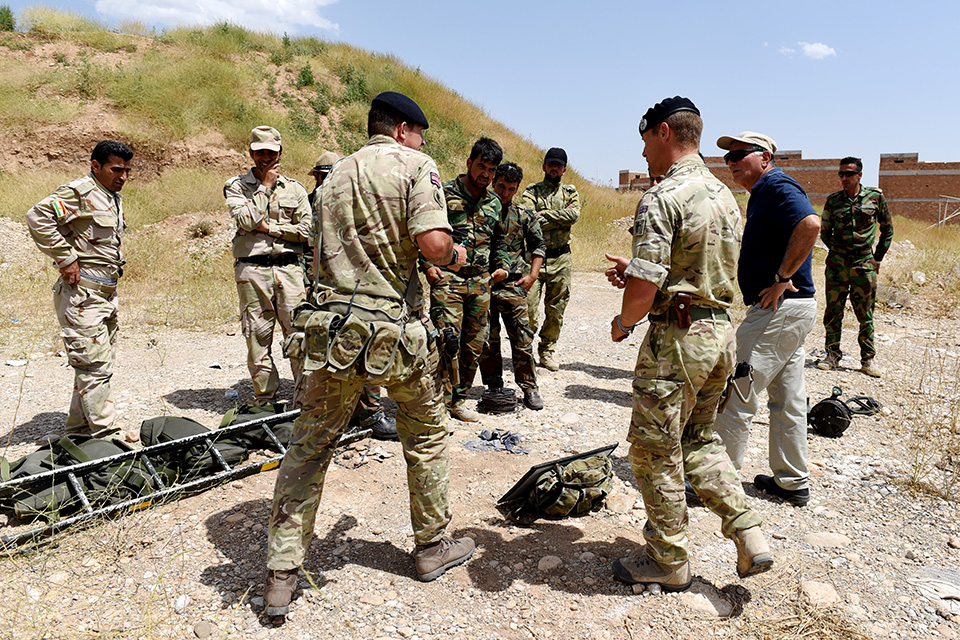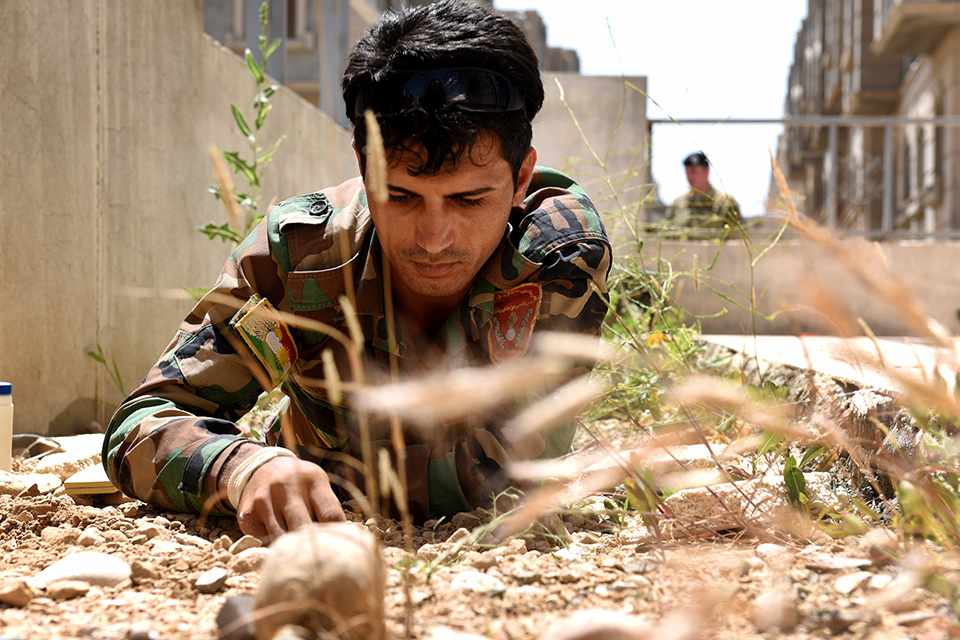RAF air strikes in Iraq and Syria: July 2015
Updated 16 December 2024
31 July:
One of our aircraft helped coordinate a strike on an ISIL position by a coalition aircraft. The Reaper then spotted terrorists burying explosives under a railway line, and was able to direct a successful attack by the supporting coalition jet. The Reaper also conducted two strikes with its own Hellfire missiles, destroying two vehicles at an ISIL-held compound.
30 July:
GR4s, responding to reports of a machine-gun attack on Kurdish troops, were able to identify a network of bunkers and tunnels near Tal Afar – three accurate strikes were conducted using Paveway IVs on the bunker and tunnel entrances.
RAF strike on ISIL vehicle in Iraq July 30
RAF strike on ISIL vehicle in Iraq July 30
RAF strike on ISIL vehicle in Iraq July 30
28 July:
A Reaper, once more supporting Iraqi forces in the western province of Anbar, spotted an ISIL armoured vehicle; it was destroyed by a direct hit from a Hellfire. The following day, Tornado GR4s patrolling in northern Iraq hit a terrorist mortar team with a Paveway.
24 July:
A Reaper was again patrolling over western Iraq, providing overwatch for Iraqi troops. The aircraft’s crew spotted an anti-aircraft gun being used by ISIL to fire on the Iraqi forces, and promptly destroyed the gun with a Hellfire. A second Hellfire accounted for a machine-gun position. The Reaper also helped coordinate a series of successful air strikes by several coalition jets, which destroyed two terrorist positions as well as a pair of armoured personnel carriers, one of which appeared to have been converted into a large car-bomb.
23 July:
Two Tornado GR4s from RAF Akrotiri, supported by a Voyager refuelling tanker, conducted two air strikes on Thursday, when they flew a close air support mission to assist the Kurdish peshmerga near Sinjar. The first attack was on a building from which a sniper was firing at the peshmerga; the precision of the Paveway IV guided bomb and careful planning by the RAF aircrew allowed a successful attack without danger to the friendly forces. Shortly afterwards, a second target was identified – a terrorist mortar position - this was also destroyed with a Paveway. Further south that day, a Reaper destroyed another ISIL supply vehicle with a Hellfire missile, and also provided surveillance support for a strike on a terrorist position by other coalition aircraft. In western Iraq, meanwhile, a Reaper identified a building from which an ISIL group were firing on Iraqi soldiers; this allowed a coalition jet to conduct a successful attack. The Reaper then mounted its own Hellfire attack to destroy a nearby heavy machine-gun position.
21 July:
A Reaper patrolling in the west of the country observed a group of terrorists attempting to plant improvised explosive devices to hold up Iraqi advances; a hit from a Hellfire missile put an end to their activities. A second Reaper was meanwhile operating further north, and it used one of its Hellfires in a highly accurate attack that destroyed an ISIL supply truck despite it being parked under a concrete roofed vehicle bay.
RAF strike on ISIL vehicle in Iraq July 21
A major part of the coalition’s strategic surveillance capability is provided by RAF Sentinel and Rivet Joint aircraft, while RAF Sentry airborne command platforms help ensure the effective coordination of the many different air forces contributing to the campaign against ISIL. On the ground, British military instructors continue to work with coalition partners to provide intensive training for the Iraqi security forces and the peshmerga; since the start of the coalition air campaign last autumn, the Iraqi and Kurdish troops have already succeeded in liberating some 25% of the territory initially seized by the ISIL extremists.
A major part of the coalition’s strategic surveillance capability is provided by RAF Sentinel and Rivet Joint aircraft, while RAF Sentry airborne command platforms help ensure the effective coordination of the many different air forces contributing to the campaign against ISIL.
On the ground, British military instructors continue to work with coalition partners to provide intensive training for the Iraqi security forces as they build their strength to drive the terrorists out of their country; since the start of the coalition air campaign last autumn, the Iraqi and Kurdish troops have already succeeded in liberating some 25-30% of the territory initially seized by the ISIL extremists.
The coalition’s programme to help train and equip the Iraqi security forces continues, with British military instructors making a significant contribution in assisting the Kurdish peshmerga in northern Iraq. The UK is taking the lead in designing a country-wide programme for the coalition to provide training and equipment to help reduce the threat from the improvised explosive devices (IED) which are increasingly favoured by the terrorists as they are forced onto the defensive. The training also now includes a Protection of Civilians element to counter the sexual violence used by ISIL as a weapon.

British Soldiers from the Royal Engineers delivers training to Kurdistan troops as part of Counter Improvised Explosive Device (CIED) training which is delivered to Kurdistan troops by British Military Personnel in Erbil, Iraq.

A Kurdistan troop takes part in training to find Improved Explosive Devices as part of his training which is being delivered to them by British Soldiers in Erbil, Iraq.
20 July:
An RAF Reaper flew overwatch for security forces in western Iraq, and was able to track a pick-up truck carrying a group of terrorists. The vehicle was destroyed by a hit from a Hellfire missile.
19 July:
GR4s again patrolled near Tal Afar, during which an ISIL mortar team opened fire on peshmerga positions. The mortar was located and attacked with a Paveway IV.
16 July:
Two GR4s provided close air support to the peshmerga in northern Iraq near Mosul and used a Paveway to destroy another mortar position which had previously fired on the Kurdish troops. The GR4s then flew west to Tal Afar, where an ISIL vehicle armed with a heavy machine-gun concealed under a building was successfully destroyed by a Paveway.
14 July:
GR4s flew close air support for Iraqi soldiers engaged in close combat with a group of ISIL extremists near Fallujah. A terrorist mortar position was identified hidden in a line of trees and, despite the friendly ground forces being close to the target, our aircraft were able to conduct a successful attack with a Paveway guided bomb without risk to the Iraqi troops.
12 July:
A further GR4 mission in northern Iraq provided assistance to the peshmerga when they again encountered an ISIL machine-gun position. Although the Kurdish forces were in close proximity to the target, careful planning and coordination by the RAF crews allowed a precision attack to be delivered with a Paveway IV which eliminated the threat to the peshmerga.
10 July:
Tornado GR4s from RAF Akrotiri, supported by a Voyager tanker, patrolled near Habbaniyah in western Iraq to support Iraqi army units operating in the area. A coalition surveillance aircraft identified an ISIL mortar position which had opened fire on the Iraqi troops, and was able to guide a successful attack by the GR4s using a Brimstone missile. Later that night, another GR4 patrol headed to northern Iraq to support Kurdish peshmerga. UK aircraft were directed to attack a building to which a group of terrorists had retreated after an engagement with the peshmerga; a Paveway IV bomb demolished the target. Another Kurdish unit then reported coming under heavy machine-gun fire; the GR4s conducted a successful Paveway attack which destroyed the building from which the terrorist machine-gun team was firing.
RAF strike on ISIL mortar position in Iraq July 10
9 July:
A Reaper observed ISIL terrorists converting an armoured pick-up truck – most likely for use as a car-bomb. Despite the target being parked in a roofed bay, the Reaper’s crew was able to score a direct hit with a Hellfire missile which destroyed the vehicle. Later, they kept close watch on a group of terrorists loading a pick-up truck with ammunition and the Reaper conducted an attack with a Hellfire. The resulting explosion destroyed the ammunition truck and another ISIL vehicle close by.
RAF strike on ISIL vehicle in Iraq July 9
6 July:
A Reaper tracked an ISIL armoured personnel carrier which was used in combat against Iraqi troops. Although the terrorists attempted to conceal their vehicle in a palm grove, this proved no defence against the Reaper, armed with Hellfire missiles. The Reaper subsequently destroyed an armoured pick-up truck, which had been converted to a large car bomb and positioned to hamper Iraqi movements.
RAF strike on ISIL vehicle in Iraq July 6 2015
5 July:
Tornado GR4s operating in northern Iraq provided support to advancing Kurdish peshmerga when they encountered a series of terrorist heavy machine-gun positions. Two were struck by Brimstone missiles and the third with a Paveway IV.
2 July:
A Reaper destroyed an engineering vehicle in western Iraq, and a GR4 patrol continued to support the Iraqi forces near Fallujah, using Paveways to attack a network of fighting positions ahead of an Iraqi advance.
1 July:
A Reaper patrolled western Iraq in support of the Iraqi army units operating in the area. Another coalition air patrol had identified an engineering vehicle which the ISIL terrorists had been using to construct defensive positions, and the Reaper was able to conduct a successful attack on the vehicle with a Hellfire missile. Later that day, Tornado GR4s from RAF Akrotiri, assisted by a Voyager air-to-air refuelling tanker, provided close air support to the Iraqi army south-east of Fallujah. A coalition surveillance platform located an ISIL mortar team, allowing the GR4s to carry out a successful attack with a Brimstone missile. The GR4s also then dropped Paveway IV guided bombs on a tunnel network in the same area.
